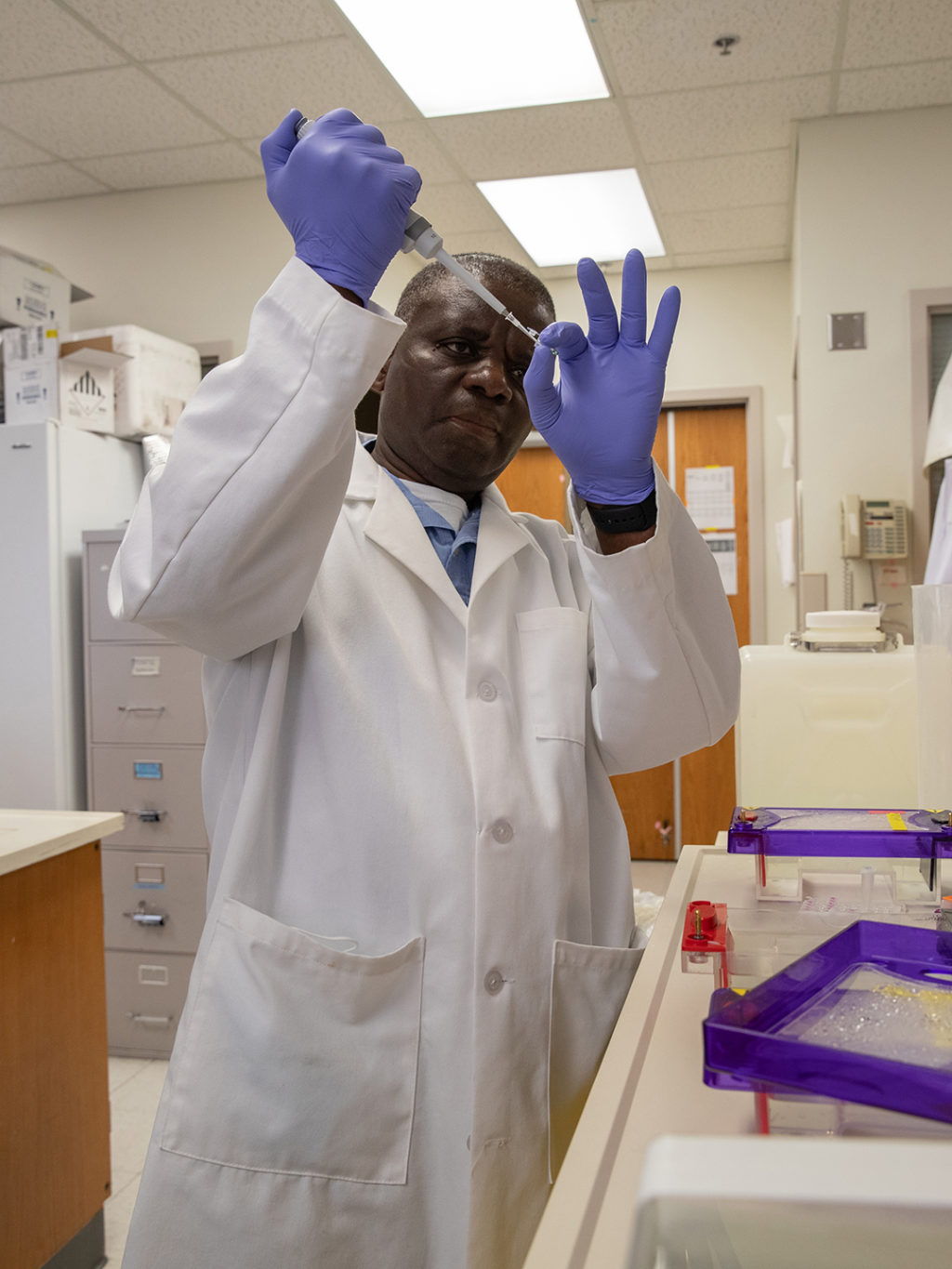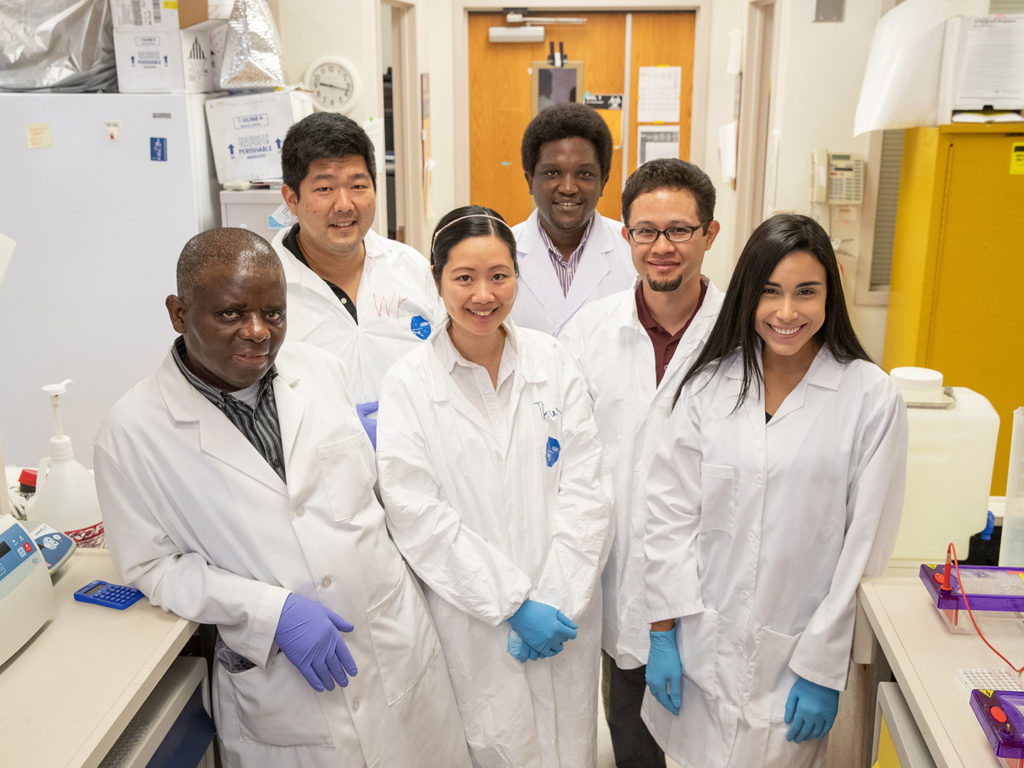VMBS Researcher Studying Ticks To Ensure Safer Future For People, Animals
Story by Margaret Preigh

Dr. Albert Mulenga, a professor in the Texas A&M School of Veterinary Medicine & Biomedical Sciences’ (VMBS) Department of Veterinary Pathobiology (VTPB), has found the research that makes him tick—ticks and tick-borne diseases.
Because these parasites pose a global threat to human, animal, and environmental health, Mulenga has taken a One Health approach to his research. As a result, his work has the potential to not only assist in the eradication of diseases that threaten human health—such as Lyme disease, Rocky Mountain Spotted Fever, and Tularemia—but also the ticks that pose a major risk to our nations’ food supply and economic stability through transmission of disease pathogens to livestock such as cattle.
Mulenga’s lab primarily focuses on understanding how ticks feed as a means through which anti-tick vaccine targets can be discovered, in hopes of ultimately developing a vaccine that prevents both the feeding and the transmission of disease agents by ticks.
This is possible because when a host is bitten by a tick, the tick injects multiple proteins and other molecules secreted through its saliva into the host. Those proteins numb the pain of puncture, which leaves the host unaware of the tick’s presence, prevents blood from clotting, suppresses host immune defenses, and allows transmitted tick-borne pathogens to colonize or establish in the host.
In collaboration with Dr. John Yates III, a chemist at the Scripps Research Institute, and Dr. Itabajara da Silva Vaz Jr., a professor at Brazil’s Federal University of Rio Grande do Sul, Mulenga’s lab has mapped secretion patterns of the proteins present in the saliva of blacklegged and lone star ticks, which transmit the majority of human tick-borne disease agents in the U.S.; cattle fever ticks, which are important to livestock production worldwide; and Asian longhorned ticks, a recent invasive species in the U.S.
“If we understand these molecules and how they facilitate tick feeding, we can block the functions of these proteases (an enzyme that breaks down proteins) and protease inhibitors (molecules that block the function of proteases) as targets for a vaccine,” he said. “If we immunize the host, when the tick tries to feed, it will not be able to.
“The beauty is that most tick-borne disease agents are not immediately transmitted when the tick starts to bite; it requires a little bit of time on the animal or human for the disease agent to be transmitted,” he said. “During that period when the tick is preparing to feed, the antibody taught to the body by the vaccine can actually work; if the immune system rejects the tick, it will not be able to transmit, and, as a consequence, we are protecting against infection.”
If ticks are unable to feed on a vaccinated population, they will eventually die off. Mulenga said their disappearance has no negative effect on the ecosystem, as they do not occupy any unique ecological function.
Catching The Science Bug
Born and raised in Zambia, Mulenga was driven to find explanations for the world around him and solve problems from an early age.
“When I was in about ninth grade, I wanted to be a mathematician,” he said. “Then in 12th grade, I had this very great chemistry teacher who changed my mind. I got excited by biology and chemistry and how we can use these two things to actually explain nature.”
After passing the university entrance exam, he was selected to attend the University of Zambia, where he studied physical sciences before transitioning into their veterinary program, which had been established only two years earlier.
In 1990, Mulenga graduated with his Bachelor of Veterinary Medicine degree and worked as an extension veterinarian. It was here that he first encountered ticks and tick-borne diseases and learned how both have major impacts on animal and human health, as well as on the food supply and economy, on a global scale.
“In Zambia, these are major hazards if you’re working in livestock production,” he said. “They’re critical. When I was working as an extension veterinarian, most of the cases we dealt with were ticks and tick-borne diseases.”
He returned to the University of Zambia as a staff development fellow, which launched an educational journey that would take him around the world, first to the University of Liverpool, England, where he earned a master’s degree in veterinary science, with a concentration in parasitology, and then to Japan’s Hokkaido University, where he earned his Ph.D. in disease control, with a focus in vaccine development.
At Hokkaido, his experiences converged when he was selected to lead a project on making vaccines against ticks.
“We were very successful. A substantial portion of my dissertation was patented in Japan,” he said. “From that, I got a postdoctoral fellowship from the Japanese Society for the Promotion of Science, which supported me for two years.”
In 2001, Mulenga headed stateside to the University of Maryland College of Medicine in Baltimore for another postdoctoral position, and then in 2005, he was recruited to join the entomology faculty at Texas A&M, where he researched tick feeding physiology for nine years.
In 2014, Mulenga relocated to the VMBS to continue his research.
An Ounce Of Prevention Is A Pound Of Cure

Because ticks can infect a wide range of hosts, Mulenga is working toward a multi-species prevention effort to control their spread.
In one project, working with Dr. Tammi Johnson at the Texas A&M AgriLife Center at Uvalde, Mulenga is working on the immunization of whitetail deer. Because these deer pose a potential risk to human and animal health, the project is funded by the Centers for Disease Control and Prevention (CDC).
“We are going to test if immunization of whitetail deer actually will prevent ticks from feeding,” he said. “Whitetail deer are the principal blood meal source for Amblyomma americanum and for Ixodes scapularis. Ixodes scapularis, or the blacklegged tick, is a principal vector of Lyme disease.”
In another project, with the National Institutes of Health (NIH), Mulenga is investigating how Borrelia bacteria, the pathogens responsible for Lyme disease, influence the tick to promote disease agent transmission. His lab has identified a number of proteins that are secreted during feeding by an infected tick and is currently trying to narrow down their list of proteins to determine which are the most important during this process.
Once Mulenga has identified the most vital proteins associated with the feeding of Borrelia-infected ticks, he can begin to develop a vaccine that will train the body to recognize and attack these proteins.
In addition, for a Kleberg Foundation-funded project with colleagues at the University of Queretaro in Mexico, the University of San Antonio, and the United States Department of Agriculture (USDA), Mulenga is working to produce recombinant antigens to protect cattle against feeding of cattle fever ticks and transmission of cattle babesia parasites.
In a related project, Mulenga and Dr. Mwangi Waithaka, a professor at Kansas State University, have been funded by the USDA’s National Institute of Food and Agriculture (NIFA) to understand the immunological basis of immunity against tick feeding in repeatedly infected cattle. He hopes to use findings from this project to better formulate anti-tick vaccines.
“In the U.S., cattle fever ticks have been controlled for more than 50 years now, but the threat is still there because these ticks are very prevalent in Mexico. Due to the high trade volume between Mexico and the U.S., there is a risk of these ticks coming back through traded cattle,” he said. “That’s why even though cattle fever ticks are currently controlled on a domestic scale, we’re trying to see if we can find some targets that we can use to make a vaccine.”
For all of these scholarly endeavors, Mulenga was awarded the Texas A&M Presidential Impact Fellow award in 2018.
Biting Into Teaching
Although Mulenga now describes teaching and guiding young scientists as one of his favorite aspects of his position, he did not foresee a calling in teaching when he began his career.
“I can remember the morning of Oct. 2, 1984, when I left for the University of Zambia,” he said. “At that time, my grandma said, ‘Go on and become a great teacher.’ I never imagined that I was going to be a teacher; my interest was to go and become a practicing veterinarian. Being a teacher just came to me—I don’t know how, but my grandma predicted it.”
In the tightly woven global community of ticks and tick-borne disease researchers, Mulenga has not only been able to collaborate with scientists he’s known since graduate school, but he is also excited to work on a project with a former student who, now, as a colleague and faculty member at the University of South Alabama, will investigate an invasive tick species from Asia that has found its way to the U.S.
“I planted the seed when she was an undergrad here and she’s now a researcher,” he said. “When a student is very curious and they have a lot of energy, it is very exciting to see that my energy transformed somebody’s life.”
Mulenga’s career also has been one of transformation—in the students he teaches, in the therapeutics he develops, and in the One Health approach he encourages for tick management to protect the food chain and human health to make a safer world for us all.
###
Note: This story originally appeared in the Summer 2022 edition of CVMBS Today.
For more information about the Texas A&M School of Veterinary Medicine & Biomedical Sciences, please visit our website at vetmed.tamu.edu or join us on Facebook, Instagram, and Twitter.
Contact Information: Jennifer Gauntt, Director of VMBS Communications, Texas A&M School of Veterinary Medicine & Biomedical Sciences; jgauntt@cvm.tamu.edu; 979-862-4216


